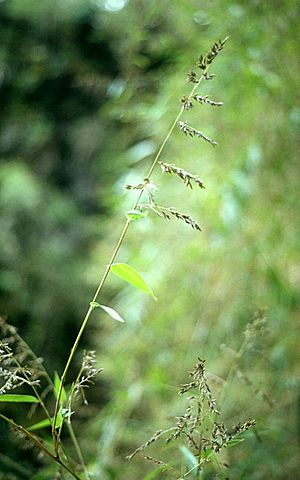Chusquea facts for kids
Quick facts for kids Chusquea |
|
|---|---|
 |
|
| Chusquea quila | |
| Scientific classification |
|
| Kingdom: | Plantae |
| Clade: | Tracheophytes |
| Clade: | Angiosperms |
| Clade: | Monocots |
| Clade: | Commelinids |
| Order: | Poales |
| Family: | Poaceae |
| Subfamily: | Bambusoideae |
| Supertribe: | Bambusodae |
| Tribe: | Bambuseae |
| Subtribe: | Chusqueinae |
| Genus: | Chusquea Kunth |
| Type species | |
| Chusquea scandens Kunth
|
|
| Synonyms | |
|
|
Chusquea is a type of bamboo plant. It belongs to the grass family. Most Chusquea bamboos grow in the mountains of Latin America. You can find them from Mexico all the way down to southern Chile and Argentina.
People sometimes call them "South American mountain bamboos." Unlike most other grasses, the stems of Chusquea bamboos are solid. They are not hollow inside. Some animals, like the Inca wren and the plushcap, live among these bamboo plants.
Contents
Cool Chusquea Species
Colihue Cane: Chusquea culeou
Chusquea culeou is known as the colihue cane. It grows in southern Chile and western Argentina. This bamboo is special because it can handle cold weather very well. It's the only South American bamboo that has grown successfully in colder places. For example, it grows as an ornamental plant (a plant grown for its beauty) in Scotland.
The Mapuche people used the colihue cane a lot. They made musical instruments from it. They also used it to make long spears during the Arauco War.
Quila Bamboo: Chusquea quila
Chusquea quila, or quila in Spanish, grows differently from colihue. It spreads out or climbs like a vine. This bamboo likes wet places. It usually doesn't grow above 500 meters (about 1,640 feet) high. Above that height, C. culeou is more common.
Chusquea quila can form thick forests by itself. These areas are called quilantales. Very few other plants can grow under these dense bamboo stands.
How Chusquea is Classified
The group of plants called Chusquea now includes species that were once in other groups. These old groups were Dendragrostis, Rettbergia, Swallenochloa, and Neurolepis. Scientists have tried to organize Chusquea into smaller subgroups. However, recent studies show that only one of these subgroups, called subg. Rettbergia, is truly a distinct group.
Images for kids
See also
 In Spanish: Chusquea para niños
In Spanish: Chusquea para niños


